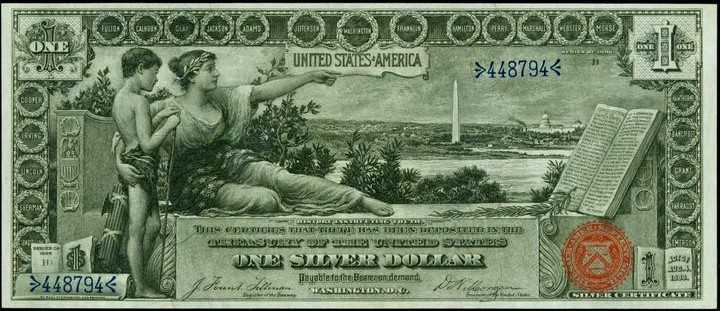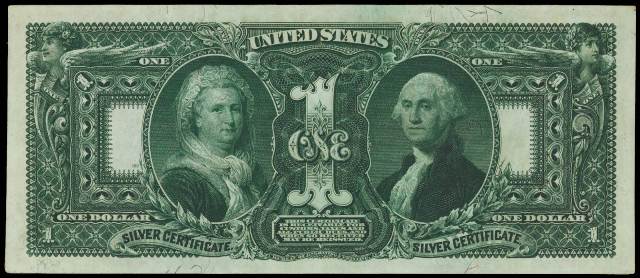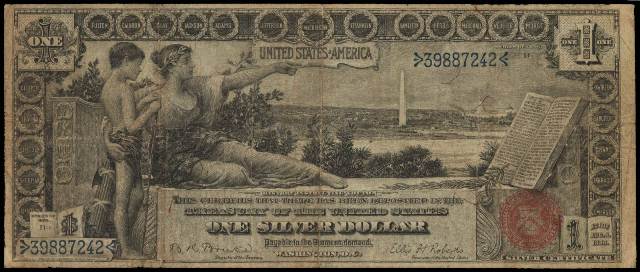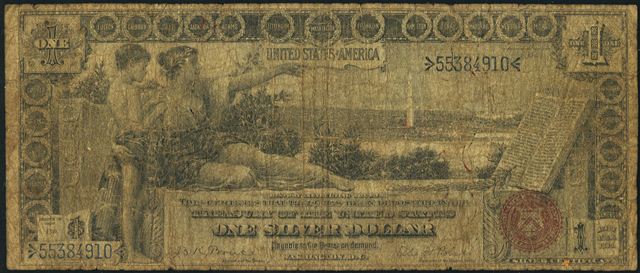Series of 1896 $1 Silver Certificate – Educational Note
History: It is a general rule that all large size one dollar bills printed by The United States are common. A collector can purchase a nice looking $1 note from 1862 to 1923 for less than $1,000 across all series. Fortunately for sellers, some series are worth more than others. The 1896 $1 silver certificate is one of the better issues. It is what collectors call a one year type design. Some one dollar bills have different series years (like 1869, 1880, 1917) but they all basically look the same. There is nothing else out there quite like the 1896 $1 silver certificate. If you want this type then you have to buy one from 1896; there are no cheaper substitutes. The two and five dollar bill from 1896 have a similar designs, but they are certainly not the same.
Nickname: Paper money dealers and collectors refer to 1896 $1 silver certificates as “one dollar eds.” This note is from the educational series, “ed” is much quicker than saying educational. Martha and George Washington are on the back of the 1896 $1 bill. However, you probably don’t want to reference either person when describing what you have. Martha Washington is much more closely associated with 1886 and 1891 one dollar silver certificates. George Washington is pictured on several different large size one dollar bills. Stick to one dollar ed and everyone will know exactly what you are talking about.
Other Facts: All 1896 $1 silver certificates have a red seal and dark blue serial numbers. The basic design shows a woman reclined and pointing towards the Washington Monument in Washington DC. She has her arm around a young boy. This design is known as history instructing youth. There is a lot of other stuff going on with this 1896 $1 bill. The document on the right hand side of the bill is actually The United States Constitution. There are also names of a couple dozen important Americans printed in wreaths around the front of the bill. Most of the people were important because of their artistic, cultural, or scientific achievements.
Values and Grading: 1896 $1 silver certificates are very common in low grades. In fact, they are also relatively common in high grades. However, there is a huge price different between the two grades. Something in absolutely perfect condition should be worth $2,000 or more. The same note in an average circulated condition is only worth about $200. There are really no wildcard factors to be aware of when dealing with 1896 $1 bills. Star notes were not issued for this series. As always, any serial number under 100 will add a nice premium. Unlike some other notes, signature combinations don’t really matter on 1896 $1 silver certificates. They were all signed by Tillman and Morgan or Bruce and Roberts. Our guides show you a little bit more about how to grade and value these bank notes.
Choice Uncirculated or Better: Most high grade 1896 $1 silver certificates that you see are going to be in the 64, 65, and 66 grade. Despite being high grade and sometimes quite valuable, all notes in that 64-66 grade are fairly easy to accurately price. They trade hands frequently, so prices are pretty well established. Anything that grades as 67 or higher is much rarer. Any 1896 $1 bill in the choice uncirculated grade should have bright, white, and crisp paper. Anything that looks like a fold probably is a fold, and should be discounted at least down to the AU grade. You have to remember that “uncirculated” is not an actual description meaning the note was never in circulation. It is just a collector term that signifies that the bill was never folded.

Extremely Fine to About Uncirculated: There are some areas of numismatics where nice XF and AU notes are not available. Fortunately for collectors there are actually lots of nice very lightly circulated 1896 $1 silver certificates. The note we have pictured below looks to be uncirculated at first glance. However, take note of the slightly rounded corners. It looks like the note might have been folded in thirds at one point. This is very typical of something in the XF and AU grade. At first glance they look perfect, but closer inspection will reveal very slight imperfections like bends or a couple of light folds. Most 1896 $1 bills that are extremely fine or about uncirculated sell for between $800 and $1,500.

The Retail Value Of An 1896 $1 Bill In This Grade Is About $1,200
Fine to Very Fine: There are hundreds, if not thousands, of 1896 $1 silver certificates in the grades between Fine 12 and Very Fine 35. The 1896 $1 bill we have pictured below is actually graded as fine 15. You can see that it shows lots of wear. The bright white paper has become dirty from changing hands frequently. A lot of collectors like to have a note in this grade. They are easy to sell and easy to value. Some notes in the 30 and 35 range are also especially appealing. Most notes will sell for between $150 and $400 in this grade.

These 1896 $1 Silver Certificates Can Be Bought For Around $200
Very Good and Lower: As we stated above, 1896 $1 silver certificates can be found in all grades. That includes poor, fair, about good, good and very good. A note in this grade will be extremely heavily circulated. Expect to find lifeless paper, stains, tears, margin damage, pinholes, and even missing pieces. We always advise spending a little bit more money and buying an 1896 $1 bill a grade higher. However, sometimes the budget won’t allow that.

An 1896 $1 Bill This Heavily Circulated Is Usually Worth Less Than $100
Need an Appraisal or Offer? We like buying notes from the 1896 educational series. We are looking to buy 1896 $1 bills in fine or better condition. Feel free to send us scans or digital photos of what you have. We will respond back quickly with the value and our offer. Sales@AntiqueMoney.com


